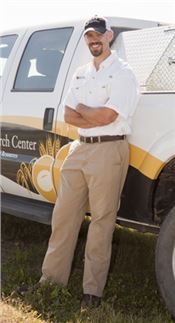|
What To Plant

Matthew Rhine, research associate at the MU Delta Center, shares his observations of
the overall best rice seed performers in the 2015 MU rice variety trial and the DD50 trial the Delta Center does.
Photo by John LaRose Jr.
Mo. Variety Trials Show Rice Yield Winners; DD50 Shows Growth Stages
BETTY VALLE GEGG-NAEGER
MidAmerica Farmer Grower
PORTAGEVILLE, MO.
The overall best rice seed performers in the 2015 MU rice variety trial are Roy J. LaKast and Mermentau. That’s the observation of Matthew Rhine, research associate at the MU Delta Center, working under Dr. Gene Stevens in cropping systems. He spoke recently about the MU variety trial for rice and the DD50 trial the center does.
“Our DD50 program is a system whereby we use growing degree days to determine predictions for the growth stage of rice,” he said. “We plant as many varieties as we can in this trial to keep track of their growth stage for our prediction models. Then we get that information out to farmers so that they can put their emergence date into the program and it will help them predict important milestones during the rice growing season, like when they should reach first tiller, when they’ll reach mid-season, and when they should be able to harvest.”
The program pulls from years and years worth of weather data to predict the growth stages of many varieties out today to help farmers keep track of their crop. Researchers consider this in tandem with the MU variety trial and try to determine which of the varieties work best for southeast Missouri.
“The best conventional varieties right now have been Roy J, LaKast and Mermentau,” Rhine said. “Those did really well in 2015, they all yielded over 200 bushel to the acre. As far as medium grains go, Jupiter still performs really well, and the MM14 which is the Missouri variety also has done well in the trials.”
Researchers are testing several new hybrids this year, including RiceTec’s CLX766 and Gemini 214CL, both of which are looking really great in the trial this year.
“We don’t have any yield data yet, but I’m very hopeful that those will do well,” he said. “Of course the other RiceTec hybrids performed really well in 2015. RiceTec’s XL753 and XP760 both yielded over 220 bushel to the acre. While they yielded about 10 percent more in this trial, the seed is more expensive so that’s something to keep in mind for your particular farm.
While yields are still being collected in the 2016 trial, Mermentau looks really good this year and Rhine has hopes it will do well. As far as the hybrids are concerned, he’s excited about the new hybrid Gemini 214CL and thinks it will do very well.
“We also have a Clearfield variety trial where we test many of the varieties from Horizon Ag. We have some excellent lines in the trial. Their CL151 still leads the pack as far as yield is concerned. In the 2015 Clearfield trial, we averaged 239 bushels to the acre across our CL151 plots. But that is followed closely by CL172 which is one of the newer Clearfield varieties, and the medium grain 271 does really well in that trial as well.
“We also have a seeding rate trial on CL172,” he said. “We plant those plots anywhere from 20 pounds, in 20-pound increments, all the way up to 120 pounds of rice per acre. Essentially, if you were to plant your field at maybe 70 pounds to the acre and there was some type of damage that reduced that stand early in the season, we want to find out if CL172 tillers enough to maintain yield under those conditions.
“In 2015 we found we can plant as low as 20 pounds to the acre and still get 192 bushel to the acre. We didn’t find a statistical difference among any seeding rates of CL172. So no matter how much or how little seed we planted of CL172, we maintained a significant yield across the board, so if there’s an issue where CL172 has a reduced stand from hail damage, armyworms or just poor emergence, that particular variety tillers out good enough that it will compensate for that,” Rhine noted.
So if a farmer is questioning whether or not to replant a field of CL172, these are the tools that can help answer that question.
“We found that if you do have a reduced stand you can get by and still make a really good yield on that particular variety,” he said.
Farmers do need to consider cost difference and results when choosing varieties.
“The cost difference in seed is significant between hybrid and conventional seed,” he said. “You will pay more for those hybrid varieties, increasing your overall break-even point. Whether or not the economics work out for your farm is a question that you’ll have to answer.”
The RiceTec hybrids do help with disease control, as they’re highly resistant to blast.
“At this point, many conventional lines out right now don’t really have a good blast resistance. So if you’re having some problems with blast in your field it might be cost effective to move to one of those hybrids that’s resistant to blast. Sheath blight is also an annual problem across the board. You get some better resistance from bacterial panicle blight and brown leaf spot from some hybrids and conventionals over others. Each variety is going to possess varying degrees of disease resistance, so it’s important to remember what diseases you’ve had in your fields in the past and what you need to combat each year.
“Choosing the right variety is much more than choosing what yields the highest. You have to look at those disease packages and see what each variety is going to bring to the table,” Rhine summed. ∆
BETTY VALLE GEGG-NAEGER: Senior Staff Writer, MidAmerica Farmer Grower
|
|